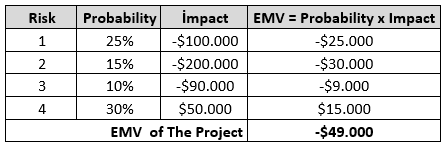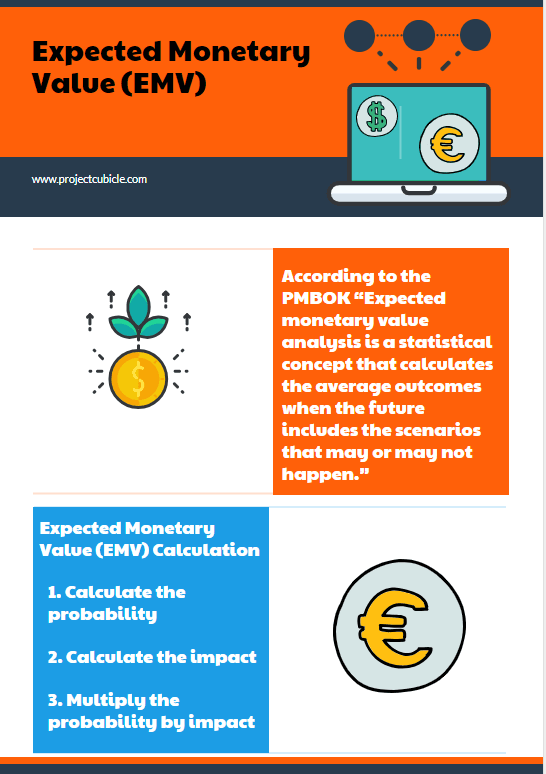The Expected monetary value analysis (EMV) is an important concept in project risk management which is used for all types of projects to make a quantitative risk analysis. As a risk management tool, Expected monetary value (EMV) helps to quantify and compare risks in many aspects of the project. It is a statistical technique that is used to convert the risk into a number and supports the project manager to determine the contingency reserve. According to the PMBOK “Expected monetary value analysis is a statistical concept that calculates the average outcomes when the future includes the scenarios that may or may not happen.” A lot of PMP aspirants find this concept difficult to understand. However, the Expected monetary value (EMV) calculation involves a few simple mathematical calculations. In this article, we will discuss the concept and analyze simple Expected monetary value (EMV) examples for better understanding.
Table of Contents
Probability and Impact
Expected monetary value calculation relies on measuring the probability and impact of each risk. Probability refers to the possibility of occurrence of a condition or an event.
For example, if you throw the dice, there is a 1/6 chance of showing the number three. Therefore, in this case, the probability of showing is three is 1/6.
The impact is the cost that you will spend when the identified risk or event happens. For example, in a housing project you identified a risk that if there is excessive precipitation during the roof works, you will spend 30,000 USD to restore the roof.
In that case, the cost of the impact will be 30,000 USD.
Expected Monetary Value (EMV) Calculation Steps
Below are the steps to be followed to calculate the EMV of a circumstance.
1. Calculate the probability of occurrence of each risk.
2. Calculate the impact of each risk as a monetary value
3. Multiply the probability by impact
Then the probability x impact multiplication gives the EMV. In the case of having multiple risks, the EMV must be calculated for each of them separately. The result can be either positive or negative. It is positive for opportunities (positive risks) and negative for threats (negative risks).
For better understanding, let’s take a look at below Expected Monetary Value Calculations.
Expected Monetary Value (EMV) Examples
Example I
You are managing a software development project and identified a risk related to market demand. The possibility of risk is 20% and if it occurs you will lose 10,000 USD. Now we will calculate the EMV of this risk.
Probability of occurrence: 20%
Impact of risk : – 10,000 USD
EMV = 0.2 x -10,000 = – 2,000 USD
Expected Monetary Value Example II
You are managing an IT project and identified a risk related to customer’s demand. However, you also identified an opportunity which increases the sales price. The possibility of risk is 10% and if it occurs you will lose 50,000 USD, on the other hand, the possibility of opportunity is 15% and if it occurs you gain 30,000 USD. Now we will calculate the EMV of this situation.
Probability of occurrence : 10%
Impact of risk : – 50,000 USD
EMV = 0.1 x -50,000 = – 5,000 USD
Probability of occurrence: 15%
Impact of risk : 30,000 USD
EMV = 0.15 x 30,000 = 4,500 USD
The EMValue of this situation is – 5,000 USD + 4,500 USD = – 500 USD
Example III
Suppose you are a project manager of a pipeline project and your project have some risks that may cause delay and cost overruns.
- Project Risk 1: There is a %25 possibility of heavy rain. This will cause a delay in the project for 3 weeks and cost 100,000 USD.
- Project Risk 2: There is a %15 percent probability of the price of rental equipment increasing, which will cost $200,000.
- Project Risk 3: There is a %10 percent probability of the price of labor increases, which will cost $90,000.
- Project Risk 4: There is a %30 possibility of increasing the productivity of excavators due to the ground conditions. This will enable to complete the project 2 weeks before and save $50,000.
Now Let’s calculate the EMV of the project

In this scenario, the project manager should add $49,000 to the project budget to manage those risks.
Benefits of Expected Monetary Value (EMV) Analysis
The EMV provides many benefits for quantitative risk analysis. Below are some of them.
- Enables to calculate contingency reserve.
- Improves statistical thinking
- Improves decision making
- Helps to select the risk management alternative which requires less cost.
- Helps to calculate the cost needed to outcome of all uncertain events.
- Forces the project manager to make cost savings during the execution.
- This technique does not require additional cost, it only requires an expert to make risk calculations.
- It can be used in conjunction with decision tree analysis.
Limitations of Expected Monetary Value (EMV) Analysis
Although the EMV is a useful technique to perform a quantitative risk analysis, it has some limitations.
- This technique gives realistic results when there is a large number of risks in the project.
- This technique is suitable for large and complex projects. It is not used in small-sized projects in general.
- The expert who is making this analysis may affect the result because of his/her personal decisions and bias.
- If the positive and negative risks are not identified properly, the result would be misleading.
- The impact of risk calculation as a monetary value may be difficult in some cases.
Summary
For successful project management, risk management techniques should be used effectively. The Expected Monetary Value (EMV) is a strong and effective tool for quantitative risk analysis. It helps to calculate the contingency reserve of the project and forces the project manager to make cost savings during the execution.
In this article, we discussed the expected monetary value analysis in risk management and analyzed expected monetary value questions and answers. Note that the EMV is an important concept from a PMP certification exam point of view. You may see one or more than one question in the exam.
See Also
Difference Between Qualitative and Quantitative Risk Analysis

Francois Simosa is the head of training for the Gragados Training Associates, which provides special project management and risk management training programs.
















Undeniably believe that that you said. Your favorite reason appeared to be at the web
the easiest thing to take into accout of. I say to you, I certainly get annoyed
whilst people consider issues that they just don’t know about.
You managed to hit the nail upon the top and also outlined out the
whole thing with no need side effect , people could take a signal.
Will probably be back to get more. Thank you
This is a great post! I have been trying to calculate EMV for a while now and this is the best explanation I have found.
This is a great post! I’m a recent graduate and I’m still trying to get my head around all of this EMV stuff. This post is really helpful.
Great post! I really appreciate the clear explanation of EMV and its applications in decision-making. The examples you provided helped me understand how to apply the concept in real scenarios. Looking forward to more insights on risk management!